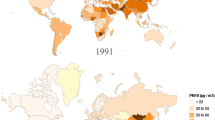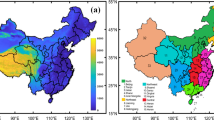Abstract
Aerosol samples were collected during the wintertime from Nov. 24, 1998 to Feb. 12, 1999 in Beijing, China. Chemical composition was determined using several analytical techniques, including inductive coupled plasma atomic emission spectroscopy (ICP-AES), graphite furnace atomic absorption spectroscopy (GFAAS) and flame atomic absorption spectroscopy (FAAS) for trace elements, ion chromatography (IC) for water-soluble ions and CHN elemental analyzer for organic carbon (OC) and elemental carbon (EC). The average concentration of aerosol was 375 ± 169 μg m−3, ranging from 136 to 759 μg m−3. Multilinear regression (MLR) analysis was performed and crustal matter, secondary particles and organics were identified as three major components of aerosol in wintertime in Beijing, accounting for 57.3% ± 9.8%, 13.4% ± 8.0%, and 22.8% ± 5.9% of the total concentration, respectively. Based on performance evaluation, Al, SO4 2− and OC were selected as tracers of the three components, with the regression coefficients of 23.5, 1.78 and 1.26, respectively. A regression constant of 19.6 was obtained, which accounts for other minor components in aerosol. On average 93.5% of the total aerosol concentration, ranging from 82% to 105%, was explained by crustal matter, secondary particle and organics. Meteorological conditions are important factors that can influence the concentration level and chemical composition of aerosols. Wind would be favorable for the pollutant dilution, leading to low aerosol levels, whereas too strong a wind may cause regional soil dust and local road dust to be resuspended resulting in a high contribution of crustal matter. Circuitous air movement, high RH% and low wind speed facilitated the secondary particle formation, not only inorganic salts, such as sulfate and nitrate, but also secondary organic carbon in a similar way.









Similar content being viewed by others
References
Appel, B. R., Tokiwa, Y., Hsu, J., Kothny, E. L., & Hahn, E. (1985). Visibility as related to atmospheric aerosol constituents. Atmospheric Environment, 9, 1525–1531.
Baik, N. J., Kim, Y. P., & Moon, K. C. (1996). Visibility study in Seoul, 1993. Atmospheric Environment, 30(13), 2319–2328.
Cao, J. J., Lee, S. C., Ho, K. F., Zhang, X. Y., Zou, S. C., Fung, K, et al. (2003). Characteristics of carbonaceous aerosol in Pearl River Delta Region, China during 2001 winter period. Atmospheric Environment, 37, 1451–1460.
Castro, L. M., Pio, C. A., Harrison, R. M., & Smith, D. J. T. (1999). Carbonaceous aerosol in urban and rural European atmosphere: Estimation of secondary organic carbon concentrations. Atmospheric Environment, 33, 2771–2781.
Chan, Y. C., Simpson, G. H., Mctainsh G. H., Vowles, P. D., et al. (1997). Characterization of chemical species in PM2.5 and PM10 aerosols in Brisbane, Australia. Atmospheric Environment, 31, 3773–3785.
Charlson, R. J., Langner, J., Rodhe, H., Leovy, C. B., & Warren, S. G. (1991). Pertubation of the northern hemisphere radiative balance by backscattering from anthropogenic sulfate aerosols. Tellus, 43 AB, 152–163.
Chen, Z. L., Zhang, Y. H., Ma, C. G., & He, F. Z. (1988). Regional pollution character of atmospheric particulate matter in Jingjin area. Environmental Science, 10(4), 24–27 (in Chinese with abstract in English).
Chi, X. G., Di, Y. A., Dong, S. P., & Liu, X. D. (1999). Determination of atmospheric aerosol organic carbon and elemental carbon. Environment Monitoring in China, 15(4), 11–13 (in Chinese with abstract in English).
Christoforou, C. S., Salmon, L. G., Cass, G. R., Hannigan, M. P., Solomon, P. A., & Cass, G. R. (2000). Trends in fine particle concentration and chemical composition in southern California. Journal of the Air and Waste Management Association, 50, 43–53.
Countess, R. J., Wolff, G. T., & Cadle, S. H. (1980). The Denver winter aerosol: A comprehensive chemical characterization. Journal of the Air Pollution Control Association, 30, 1194–1200.
Dan, M., Zhuang, G. S., Li, X. X., Tao, H. R., & Zhuang, Y. H. (2004). The characteristics of carbonaceous species and their sources in PM2.5 in Beijing. Atmospheric Environment, 38, 3443–3452.
Dockery, D. W., & Pope, C. A. (1994). Acute respiratory effects of particulate air pollution. Annual Review of Public Health, 15, 107–132.
Duan, F. K., Liu, X. D., Dong, S. P., Lu, Y. Q., Yu, T., & Cachier, H. (2004). Identification and estimate of biomass burning contribution to the urban aerosol organic carbon concentration in Beijing. Atmospheric Environment, 38, 1275–1282.
Duan, F. K, Liu, X. D., He, K. B., Lu, Y. Q., & Wang, L. (2003). Atmospheric aerosol concentration level and chemical characteristic of its water-soluble ionic species in wintertime in Beijing, China. Journal of Environmental Monitoring, 5, 569–573.
Environmental Status Communique of Beijing Environmental Protection Bureau, China, http://www.bjepb.gov.cn.
Goss, K.-U., & Schwarzenbach, R. P. (1998). Gas/solid and gas/liquid partitioning of organic compounds: Critical evaluation of equilibrium constants. Environmental Science & Technology, 32, 2025–2032.
He, K., Yang, F., Ma, Y., Zhang, Q., Yao, X., Chan, C. K., et al. (2001). The characteristics of PM2.5 in Beijing, China. Atmospheric Environment, 35, 4959–4970.
In, H. J., & Park, S. U. (2003). Estimation of dust emission amount for a dust storm event occurred in April 1998 in China. Water, Air and Soil Pollution, 148, 201–221.
Lewis, C. W., Baumgardner, R. E., & Stevens, R. K. (1986). Receptor modeling study of Denver winter haze. Environmental Science and Technology, 20, 1126–1136.
Lin, J. J., & Tai, H. S. (2001). Concentrations and distributions of carbonaceous species in ambient particles in Kaohsiung City, Taiwan. Atmospheric Environment, 35, 2627–2636.
Lipfert, F. W., & Wyzga, R. E. (1995). Air pollution and mortality, issues and uncertainties. Journal of the Air and Waste Management Association, 45, 949–966.
Liu, X. D., Chi, X. G., Duan, F. K., Dong, S. P., & Yu T. (2000). Determination of organic carbon and elemental carbon in Chinese urban aerosols by using CHN elemental analyzer. Journal of Aerosol Science, 31(supplement 1), s240–s241.
Novakov, T., & Penner, J. E. (1993). Large contribution of organic aerosols to cloud-condensation nuclei concentrations. Nature, 365, 323–365.
Salma, I., Chi, X. G., & Maenhaut, W. (2004). Elemental and organic carbon in urban canyon and background environments in Budapest, Hungary. Atmospheric Environment, 38, 27–36.
Salvador, P., Artinano, B., Alonso, D. G., Querol, X., & Alastuey, A. (2004). Identification and characterization of sources of PM10 in Madrid (Spain) by statistical methods. Atmospheric Environment, 38, 435–447.
Schmid, H., Laskus, L., Abraham, H. J., Baltensperger, U., Lavanchy, V., Bizjak, M., et al. (2001). Results of the carbon conference international aerosol carbon round robin test stage I. Atmospheric Environment, 35, 2111–2121.
Schwartz, J. (1993). Particulate air pollution and chronic respiratory disease. Environmental Research, 62, 7–13.
Seinfeld, J. H., & Pandis, S. N. (1998). Atmospheric chemistry and physics from air pollution to climate change. New York: Wiley.
Sievering, H., Boatman, J., Galloway, J., Keene, W., Kim, Y., Luria, M., et al. (1991). Heterogeneous sulfur conversion in sea-salt aerosol particles, the role of aerosol water content and size distribution. Atmospheric Environment, 25, 1479–1487.
Sun, Y. L., Zhuang, G. S., Zhang, W. J., Wang, Y., & Zhuang, Y. H. (2006). Characteristics and sources of lead pollution after phasing out leaded gasoline in Beijing. Atmospheric Environment, 40, 2973–2985.
Turpin, B. J., & Huntzicher, J. J. (1995). Identification of secondary organic aerosol episodes and quantisation of primary and secondary organic aerosol concentrations during SCAQS. Atmospheric Environment, 29, 3527–3544.
Viidanoja, J., Sillanpaa, M., Laakia, J., Kerminen,V., Hillamo, R., Aarnio, P., et al. (2002). Organic and black carbon in PM2.5 and PM10, one year of data from an urban site in Helsinki, Finland. Atmospheric Environment, 36, 3139–3183.
Wai, K. M., & Tanner, P. A. (2005). Case studies of Asian dust storm impacts on a coastal site: Implication of a good dust storm tracer. Water, Air and Soil Pollution, 168, 59–70.
Yao, X. H., Lau, A. P. S., Fang, M., Chan, C. K., & Hu, M. (2003). Size distributions and formation of ionic species in atmospheric particulate pollutants in Beijing, China. 1. Inorganic ions. Atmospheric Environment, 37, 2991–3000.
Yu, J. Z., Huang, X. F., Xu, J. H., & Hu, M. (2005). When aerosol sulfate goes up, so does oxalate, implication for the formation mechanisms of oxalate. Environmental Science and Technology, 39, 128–133.
Zheng, M., Salmon, L. G., Schauer, J. J., Zeng, L. M., Kiang, C. S., Zhang, Y. H., et al. (2005). Seasonal trends in PM2.5 source contributions in Beijing, China. Atmospheric Environment, 39, 3967–3976.
Acknowledgments
This study was supported by The National Basic Research Program of China (no. 2003CB415003), the National Science Foundation of China (20177036, 20477042), and China State Environmental Protection Administration (97510). Beijing EPB is appreciated for supplying us the meteorological information and auto-monitoring data of SO2. We also appreciate Dr. Iwamoto for his helps and suggestions in performing MLR software.
Author information
Authors and Affiliations
Corresponding author
Rights and permissions
About this article
Cite this article
Duan, F.K., Liu, X.D., He, K.B. et al. Characteristics and Source Identification of Particulate Matter in Wintertime in Beijing. Water Air Soil Pollut 180, 171–183 (2007). https://doi.org/10.1007/s11270-006-9261-4
Received:
Accepted:
Published:
Issue Date:
DOI: https://doi.org/10.1007/s11270-006-9261-4




